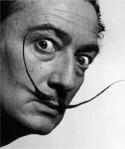
Click here to buy Sale Posters!
Salvador Dali Biography
 Salvador Dali was born on May 11, 1904 in the small agricultural town of Figueres, Spain.
Figueres is located in the foothills of the Pyrenees, only sixteen miles from the French border in the principality
of Catalonia. The barren landscapes and fantastic rock formations of this region would appear time and again
in Dali's artwork. The son of a prosperous notary, Dal� split his boyhood between Figueres and the family's summer
home in the coastal fishing village of Cadaques where his parents built his first studio. As an adult, he made his
home with his wife Gala in nearby Port Lligat. His love of this area of Spain was also reflected in his paintings.
Salvador Dali was born on May 11, 1904 in the small agricultural town of Figueres, Spain.
Figueres is located in the foothills of the Pyrenees, only sixteen miles from the French border in the principality
of Catalonia. The barren landscapes and fantastic rock formations of this region would appear time and again
in Dali's artwork. The son of a prosperous notary, Dal� split his boyhood between Figueres and the family's summer
home in the coastal fishing village of Cadaques where his parents built his first studio. As an adult, he made his
home with his wife Gala in nearby Port Lligat. His love of this area of Spain was also reflected in his paintings.
Salvador attended the San Fernando Academy of Fine Arts in Madrid. Early recognition of his talent came with his first one-man show in Barcelona in 1925. Dali became internationally known when three of his paintings, including The Basket of Bread (now in the Museum's collection), were shown in the third annual Carnegie International Exhibition in Pittsburgh in 1928.
"The only difference between me and a madman is that I am not mad."
The following year, Dal� held his first one-man show in Paris. He also joined the surrealists, led by former Dadaist Andre Breton. That year, Dal� met Gala Eluard when she visited him in Cadaques with her husband, poet Paul Eluard. She was to become Dal�'s lover, muse, business manager, and chief inspiration.
Dal� soon became a leader of the surrealist movement. His painting, The Persistance of Memory, with the soft or melting watches is still one of the best-known surrealist works. But as the war approached, the apolitical Dal� clashed with the surrealists and he was "expelled" from the surrealist group during a "trial" in 1934. He did, however, exhibit works in international surrealist exhibitions throughout the decade. But by 1940 Dal� was moving on to a new style. This period, marked by a preoccupation with science and religion, is referred to as his "classic" period.
Dal� and Gala escaped from Europe during World War II and spent 1940-1948 in the United States. This was significant to his career as in 1941 the Museum of Modern Art in New York gave Dali his first major retrospective exhibit.
As Dal� moved away from Surrealism and into his classic period, he began his series of 19 large canvases, many concerning scientific, historical or religous themes. Among the best known of these works are The Hallucinogenic Toreador, The Discovery of America by Christopher Columbus, and The Sacrament of the Last Supper, which is now in the National Gallery in Washington, D.C.
"Have no fear of perfection. You'll never reach it."
In 1974, Dal� opened the Teatro Museo in Figueres, Spain. This was followed by retrospectives in Paris and London at the end of the decade. After the death of his wife, Gala, in 1982, Dal�'s health began to fail. It deteriorated further after he was burned in a fire in his home in Pubol in 1984. Two years later, a pace-maker was implanted. Much of this part of his life was spent in seclusion, first in Pubol and later in his apartments at Torre Galatea, adjacent to the Teatro Museo. Salvador Dal� died on January 23, 1989 in Figueres from heart failure with respiratory complications.
As an artist, Salvador Dal� was not limited to a particular style or media. The body of his work, from early impressionist paintings through his transitional surrealist works, and into his classical period, reveals a constantly growing and evolving artist. Dal� worked in all media, leaving behind a wealth of oils, watercolors, drawings, graphics, and sculptures. He also designed and produced surrealist films, illustrated books, handcrafted jewelry, and created theatrical sets and costumes. Among his writings are ballet scenarios and several books, including The Secret Life of Salvador Dal� (1942) and Diary of a Genius (1965).
Though Dali's art and the symbols he employs are often difficult to interpret, they nevertheless strike a responsive chord with a diverse audience. Salvador Dali remains one of the most popular artists with collectors and art lovers.
These are just a sampling of Salvador Dali's best known works: Metamorphosis of Narcissus, Allegorie de soie, Swans Reflecting Elephants, The Elephants, Christ of Saint John of the Cross, The Persistence of Memory, Landscape with Butterflies, Clock Explosion, Person at the Window, Reminiscence Archeologique De L'angelus, The Ship, Musical Tempest (Red Orchestra), Hallucinogenic Toreador, Meditative Rose, Tiger, Apparition of Face and Fruit Dish, Female Figure with Head of Flowers, Gala Contemplating the Mediterranean, Paysage Aux Papillons, Temptation of St. Anthony, Sacrament of the Last Supper, Discovery of America, Saint Jacques Le Grand, Galatea of the Spheres, Geopoliticus Child, Idylle Atomique, Disintegration of Pers., Girafe En Feu, Crucifixion, Sleep, Maelstrom, Disintegration of Persistence of Memory, Female Rose, Bacchanale, Aphrodite de Cnide, Giraffe on Fire, Millet's Architectonic Angelus, The Rose. Featured books: Dali (Mallard Fine Art Series) (Hardcover) by Paul Moorhouse, Salvador Dali, The Secret Life of Salvador Dali by Salvador Dali, Salvador Dali by Salvador Dali, Luis Romero (Hardcover - March 2004).
�
Copyright � 2004- by Ace Toscano. All rights reserved.
�
(We are not affiliated with sites or advertisers promoted in paid ads appearing on this or any page.)
�
�
